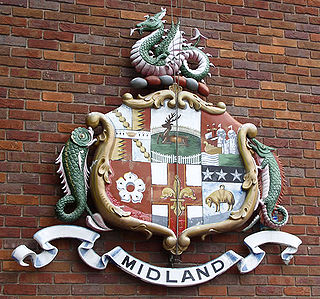Burton Wanderers Football Club was a football club based in Burton upon Trent, Staffordshire, England. The club were members of the Football League for three seasons in the mid 1890s. In 1901 they merged with Burton Swifts to form Burton United. The club played at Derby Turn.

Pirelli Stadium is an association football stadium on Princess Way in Burton upon Trent, Staffordshire, England. It was built in 2005 and is the current home of Burton Albion F.C., replacing the club's old Eton Park home, also on Princess Way, which was demolished and developed into housing. The ground was built on the former site of the Pirelli UK Tyres Ltd Sports & Social Club, and having had the land donated to the club by Pirelli, in return for naming rights, the ground cost £7.2 million to build.
The 1892–93 season was the fifth season of The Football League. This season saw the introduction of the Second Division.
The 1893–94 season was the sixth season of The Football League.
The 1894–95 season was the seventh season of The Football League.
The 1894–1895 FA Cup was the 24th season of the world's oldest association football competition, the Football Association Challenge Cup. The cup was won by Aston Villa, who defeated West Bromwich Albion 1–0 in the final of the competition, played at Crystal Palace in London. This was Villa's second victory in the FA Cup.
The 1895–1896 FA Cup was the 25th season of the world's oldest association football competition, the Football Association Challenge Cup. The cup was won by The Wednesday, who defeated Wolverhampton Wanderers 2–1 in the final of the competition, played at Crystal Palace in London. This was Wednesday's first victory in the FA Cup.
The 1892–93 season was Ardwick A.F.C.'s second season of league football. Following the amalgamation of the Football Alliance with the Football League, Ardwick was elected to the new Second Division in the inaugural season of two-tier football in England, and the season marked the start of Ardwick 's exactly 100-year stay in the Football League before leaving in 1992 to co-found the Premier League.
The 1893–94 season was Ardwick A.F.C.'s third season of league football and second season in the Football League. In the latter half of the season, financial difficulties forced the reorganisation of the club into the team Manchester City F.C. on the day of their last league game of the season. By this name the club have been known for the rest of their history.
Billy May was an English footballer who played in the Football League for Notts County and Burton Swifts.
The 1888–89 season was the first season of competitive league football in the history of English football club Wolverhampton Wanderers. They played in the inaugural season of the newly formed Football League. The club finished in third place in the league, and as runners-up in the FA Cup.
The 1896–97 season was the 16th season of competitive association football and 5th season in the Football League played by Small Heath F.C., an English football club based in Birmingham. In 1895–96, Small Heath finished in 15th position in the 16-team First Division and were relegated via the test match system. In 1896–97, they finished 4th in the Second Division.
Cassio Road, also known as the West Herts Sport Ground, is a sports ground in Watford in England. It was the home ground of Watford F.C. between 1898 and 1922.
The Castle Ground was a cricket and football sports ground in The Meadows area of Nottingham, England. It was used by Notts County football club between 1880 and 1894.
The Town Ground was a football ground in Nottingham in England. It was the home ground of Nottingham Forest, and the first ground to host a football match using crossbars and goal nets.

Pike's Lane was a football ground in Bolton, England. It was the home ground of Bolton Wanderers between 1880 and 1895, and the venue of the first-ever goal scored in league football anywhere in the world.
Wellington Road was a football ground in the Perry Barr area of Birmingham, England. It was the home ground of Aston Villa from 1876 until 1897.
Springvale Park was a football ground in the Cowlairs area of Glasgow, Scotland. It was the home ground of Cowlairs F.C. during their time in the Scottish Football League.
Crawick Holm was a football ground in Sanquhar, Scotland. It was the home ground of Nithsdale Wanderers.







